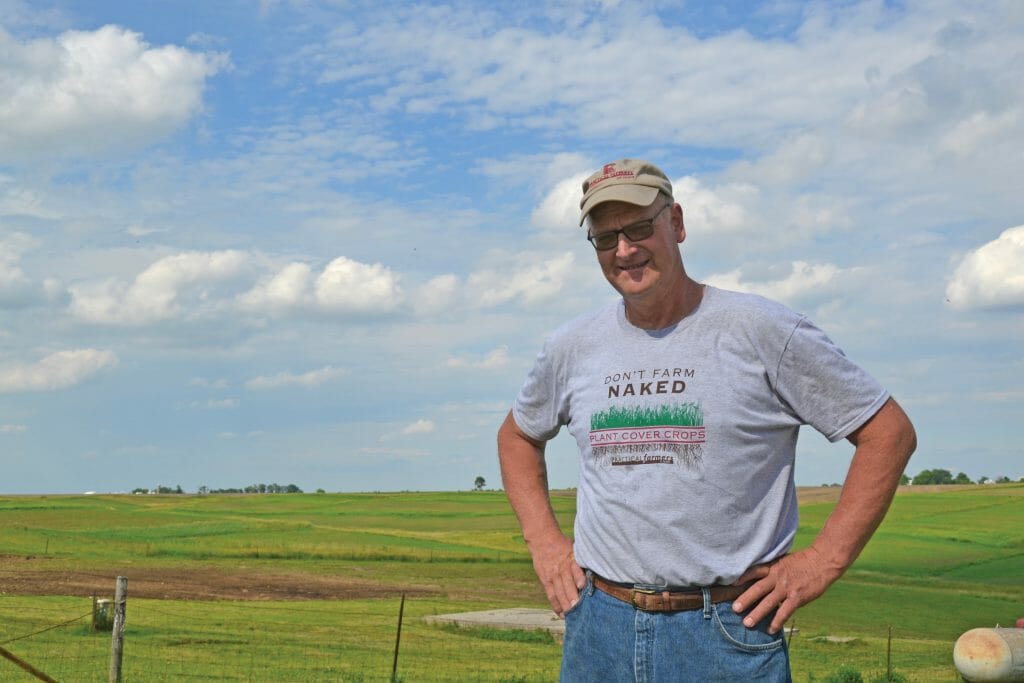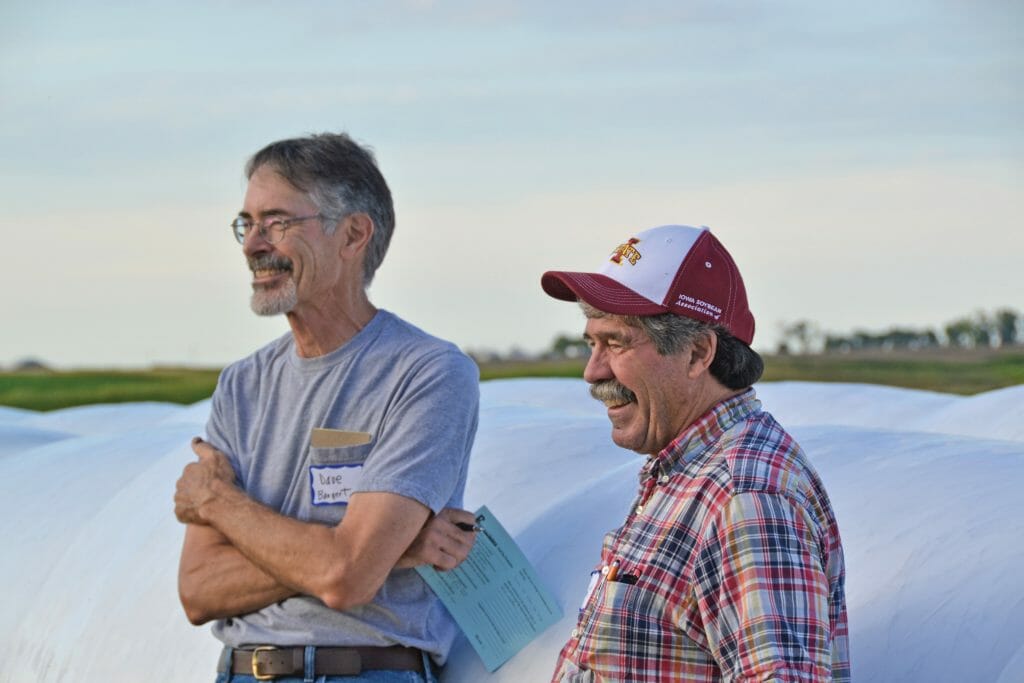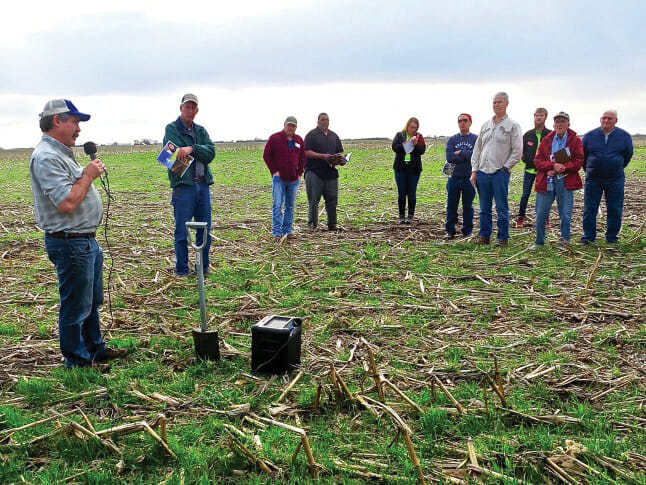Using Science & On-Farm Research to Investigate Cover Crops in Iowa
In recent years, trials in Practical Farmers of Iowa’s Cooperators’ Program have been dominated by cover crops: over the past three years, 131 of all 233 on-farm research trials – or nearly 60% – have involved cover crops.
Thanks to this interest, and the efforts of the cooperating farmers conducting the research, evidence continues to mount about the benefits of cover crops and the management practices that can lead to success.
To ensure sound evidence, participating farmers follow principles of rigorous experimental design when conducting experiments on their farms. Treatments are chosen to address specific questions and objectives, and are then applied to randomized and replicated strips across a farm field to account for any variation within the field. The strips are at least as wide as one combine pass and run the length of the field. Such trials mimic plot experiments conducted by university scientists.
Do cover crops affect crop yields?
In 2008, PFI partnered with Iowa Learning Farms to recruit 12 farmers for a long-term study testing the effect of a cereal rye cover crop on corn and soybean yields. At that time, the benefits of using cover crops to prevent soil and nutrient loss from fields were well-established in the academic literature. The presence of roots during the fall, winter and spring holds soil in place and soaks up extra nutrients left over from cash crop production.
But less was known about how corn and soybeans would respond to cover crops. Many people – farmers and researchers alike – viewed any plant growing in the spring before corn or soybeans were planted as a weed that would reduce yields. Ten years ago, this was the major concern on a lot of farmers’ minds (and it’s still probably on many farmers’ minds today).
To investigate this concern, the farmers participating in the study agreed to establish replicated strips in which they either seeded a cereal rye cover crop in the fall or left the soil bare (no cover crop). The following spring, the farmers terminated the cover crop in the strips and planted corn or soybeans in the entire field. Come harvest time, we compared grain yields from the cover crop strips and bare strips.
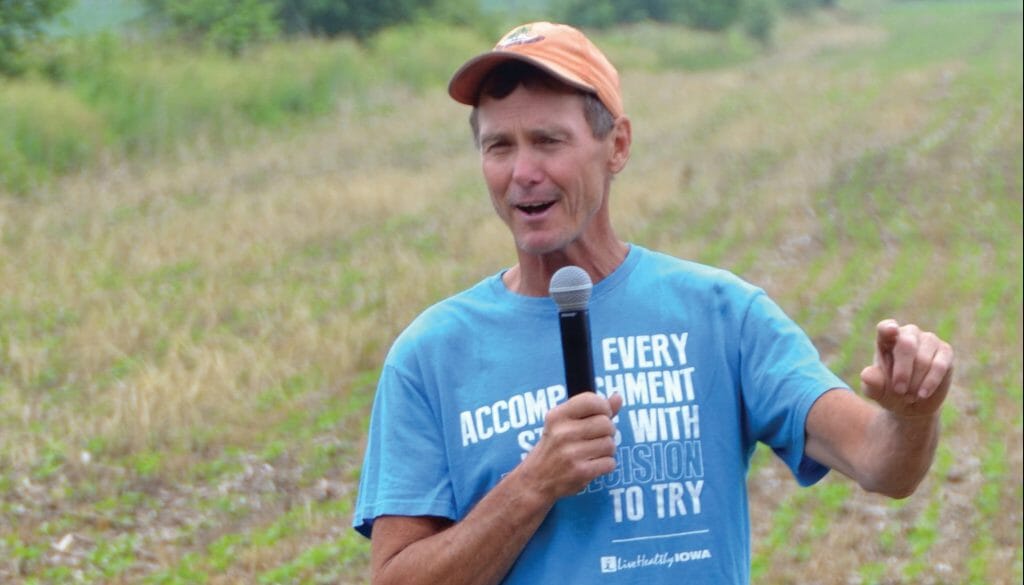
George Schaefer stands in his cover crop field near Kalona while speaking to a crowd during a PFI field day he hosted in 2015.
Over 10 years, the cereal rye cover crop has had no effect on corn yields across 32 of the total 39 individual on-farm trials that involved corn in this study. While the cover crop did reduce corn yields in some cases, most of those instances occurred in the first two years of the study. The farmers who experienced yield drag blamed the reduced yields on challenges associated with terminating their cover crop and planting corn into cover crop residue. In other words, the farmers were trying something new and ran into a few hurdles.
After a few years of experience, the participating farmers have overcome these challenges. They now more vigilantly monitor temperatures in the spring to ensure herbicide efficacy when spraying the cover crop, and carefully adjust planter settings to ensure proper seeding depth and closure of the trench as the corn seed is placed into the soil. “The difference in our knowledge about cover crops between the time we started and now is huge,” says George Schaefer, one of the farmers involved in the study. As the farmers gained more experience over the course of the study, they virtually eliminated any harmful effects of the cover crop on corn.
The difference in our knowledge about cover crops between the time we started and now is huge. – George Schaefer
In soybeans, the story is similar – but with a bit of a twist. Over 10 years, the cereal rye cover crop has had no effect on soybean yields across 20 of 29 trials. Unlike with corn, however, three farms saw improved soybean yield from the cover crop in the first three years of the experiment. In fact, the cover crop has boosted soybean yields eight times over the course of the study, and we found that those yield increases became more frequent as the study progressed. This has led many to suggest that the learning curve for growing soybeans after a cereal rye cover crop is much less steep than for corn.
Most importantly, this long-term study has produced results similar to recent experiments by researchers at Iowa State University and Michigan State University that found cereal rye cover crops do not negatively affect corn and soybean yields. Both farmers and researchers agree that the key to avoiding negative effects lies with proper management.
What is “proper management” when cover crops are involved?
With the results of these studies in mind, the focus of PFI on-farm research has evolved to investigate practices that lead to consistent cover crop success. For instance, more recent studies have explored when to terminate a cereal rye cover crop relative to planting corn or soybeans, as well as when and how much nitrogen fertilizer to apply to corn following a cover crop. These are practical management decisions a farmer has control over, and their effects on crop production can easily be tested with on-farm strip trials.
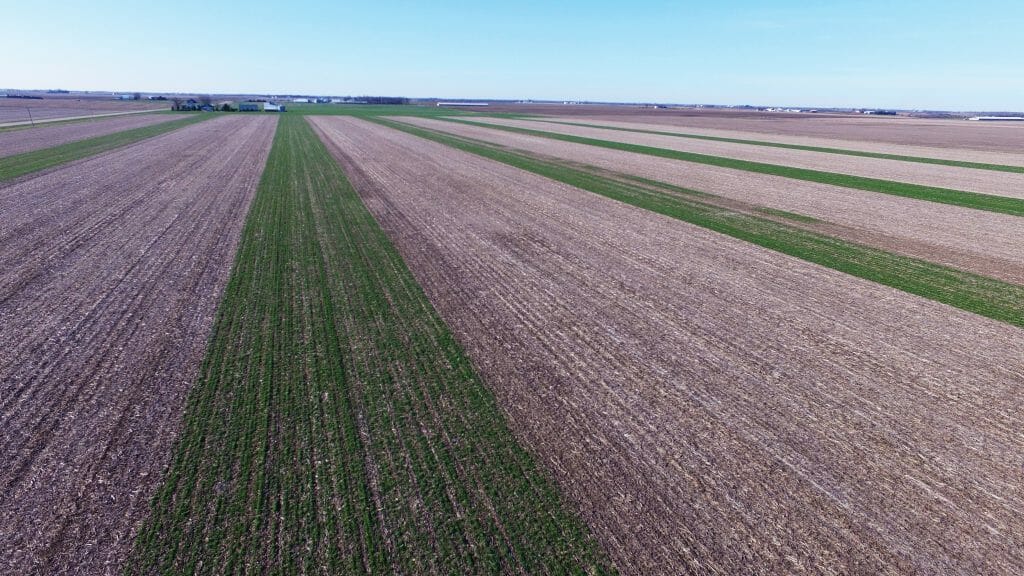
George Schaefer stands in his cover crop field near Kalona while speaking to a crowd during a PFI field day he hosted in 2015.
When should cover crops be terminated?
As a general rule of thumb, cereal rye cover crops are terminated 10 to 14 days before planting cash crops to avoid competition between the cover crop and cash crop for soil moisture and nutrients. Following this advice, farmers wishing to plant corn in mid- to late April would thus have to kill the cover crop in early April, when the cereal rye might only be 6 or 7 inches tall. But those who’ve used cover crops for a few years have found that the bigger the cover crop, the greater the benefits to weed control and water quality.
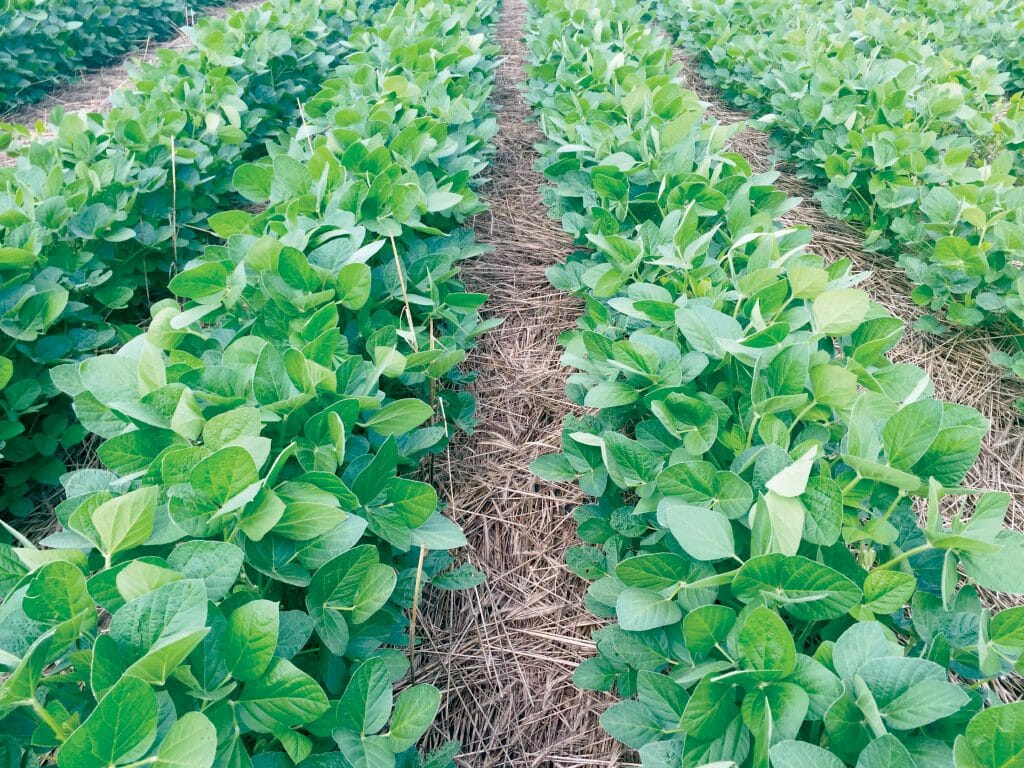
Soybeans with cover crop mulch from one of Jack Boyer’s trials show how a cover crop can aid weed suppression.
There are two ways to get more cover crop growth: You can either hope for above-normal temperatures in March, or let the cover crop grow longer into April or May. Because a farmer has more control over the latter, PFI cooperators set up on-farm research trials to test whether they could push the recommendations for terminating cover crops.
The trials compared strips where the cover crop was terminated 14 days before planting corn or soybeans with strips where the cover crop was terminated within one or two days of planting corn or soybeans, a practice known as planting green. In these experiments, the target corn or soybean planting date was not altered; the farmers planted between mid-April and early May when they normally would, and delayed their cover crop termination date.
Between 2016 and 2018, Dick Sloan, Tim Sieren and Arlyn Kauffman collectively conducted five on-farm experiments that tested this concept with corn. Across the farms, waiting to kill the cover crop until close to corn planting time nearly triples cover crop growth compared with when it was terminated 14 days earlier – but corn yields decreased by 14 bushels per acre, on average. “It’s the carbon penalty of cover crops to corn,” Tim says. The extra cover crop growth each farmer saw came at the expense of reduced corn yields.
Results from similar studies by researchers at North Carolina State University and Iowa State University also report reduced corn yields when narrowing the gap between cover crop termination and corn planting. The authors suggest the yield drops may stem from cereal rye tying up nitrogren and making it unavailable to corn, coupled with increased disease pressure on corn seedlings. Combined with the PFI research, it appears that following the rule of thumb to terminate a cover crop 10 to 14 days before planting is sound advice for corn following a cover crop.
But what about soybeans? Findings from Jack Boyer and Jeremy Gustafson in 2015 and 2016 suggest a different story. Both planted soybeans into a newly terminated cover crop that produced as much as 7,000 pounds of growth per acre. But their soybeans yielded the same as those following a cover crop that had been killed two weeks prior. Across the four trials, Jack’s and Jeremy’s soybeans yielded an average of 63 bushels per acre, regardless of cover crop termination date. “The most interesting part of the trial,” Jack says, “was the improved weed control.”
It turns out the heftier cover crop growth achieved by delaying termination until soybean planting served as a mulch that reduced weed pressure. In two of the four trials, this mulch let Jack and Jeremy eliminate one weed management pass through the field. Both said the money they saved as a result more than paid for the cost of the cover crop. Based on these results, it seems soybeans are more flexible than corn about when cover crops can be terminated. This leeway also gives farmers a possible way to save money on weed control – and thus to find the “cash in cover crops.”
If you opt to try planting soybeans “green,” it’s important to know the practice can result in a lot of cover crop growth – the cereal rye might be 6 or 7 feet tall. In a 2017 trial, Jack found it helpful to roll down the tall cover crop residue after terminating with an herbicide and a few days after seeding soybeans in 30-inch rows with a planter. In strips where he did not roll after terminating and seeding, much of the cover crop residue was still standing by the fall, which led to challenges harvesting the soybeans.
His yields also dropped by 13 bushels per acre compared to where he rolled the cover crop down. Neither were issues, however, where Jack seeded soybeans in 10-inch rows with a drill. The drill effectively laid the cover crop down during soybean seeding, and it stayed down for the rest of the summer through harvest. Rolling the cover crop also proved unnecessary: Yields were no different where Jack did not roll, and his cost of production was also lower.
Do I need more nitrogen for corn after a cover crop?
Because corn is considered a heavy feeder when it comes to nitrogen – and because cover crops take up residual soil nitrogen – some farmers wonder if corn needs more fertilizer after a cereal rye cover crop. Results from eight on-farm trials between 2010 and 2017 seem to dispute this idea. Across these trials, Rob Stout, Tim Smith, Jeremy Gustafson and Dick Sloan seeded a cereal rye cover crop in the fall, which they terminated two weeks before planting corn the next spring.
They then compared their typical nitrogen fertilizer rate with a rate they increased by 30 to 50 pounds per acre when sidedressing in June. In seven of the eight trials, the higher nitrogen rate had no effect on corn yields. The results suggest there’s no need to apply extra nitrogen fertilizer beyond your typical rate when you follow the recommendation to terminate your cover crop at least 10 days prior to planting corn.
Anecdotally, farmers are reporting success with splitting their typical nitrogen rate into two installments: the first, at least 30 pounds of nitrogen per acre, at the time of corn planting, with the rest applied when sidedressing in June. This, along with waiting 10 to 14 days to plant corn after terminating the cover crop, may help to overcome the early-season soil nitrogen depletion caused by the cover crop.
So what have we learned?
Research by farmers in PFI’s Cooperators’ Program has led to several major findings. One of the most significant is that cover crops, for the most part, don’t reduce corn and soybean yields – if they are properly managed.
Management is key. For corn, this means terminating the cover crop roughly two weeks before planting corn and sticking with your typical nitrogen fertilizer rate. Soybeans, however, are a bit more forgiving than corn. Proper management can involve planting soybeans shortly before or shortly after terminating a cover crop (planting green). Waiting longer to kill the cover crop in soybeans doesn’t affect yields and can benefit weed management.
Some of these findings are verified by related university research. Other university research on cover crops over the years has shown reduced soil erosion, nutrient loss and soil compaction, as well as improved soil structure. Future studies will build on these findings.
One experiment will explore the effect of delaying cover crop termination until well after the soybean planting date to reap more cover crop growth and more consistent weed control. Another will test creative ways to increase cover crop diversity beyond cereal rye.
These findings would not be possible without curious farmers driven to find solutions that can better their operations and their broader impact. “I like to figure out what works on my farm,” says Tim Sieren about why he conducts on-farm research. “It wasn’t until I got involved with Practical Farmers that someone could analyze things and put numbers to what I was trying with cover crops.”
These findings would also not be possible without a commitment to improving. While Rob Stout, one of the participants in the long-term cover crop study, was presenting about the study at PFI’s annual Cooperators’ Meeting in December 2018, he was asked why he participated and why he uses cover crops on his farm. He simply and firmly responded: “Because it’s the right thing to do.”

